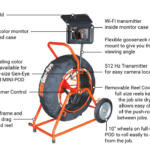What a lot of people who aren’t very invested into photography frequently underestimate is the importance of lenses. However, every professional photographer aims to add as many lenses to his arsenal as humanly possible. Lenses have the power to make or break a picture. They control the picture that’s projected onto your imaging sensor and are the ultimate deciders of what kind of photos you’ll have. That being said, most photographers would rather shoot with an average camera and great lens, than a great camera with no lens.
Before you buy camera lenses there is a number of things you have to consider. Looking at the specs of a lens will leave you riddled by the amount of letters and numbers written. Luckily though, you can safely ignore some of them, and focus on just a couple – focal length, image stabilization, aperture, format and lens mount.

Focal Length
The first number you usually see on a lens is the focal length combined with the camera’s sensor size. This defines the view angle covered by the lens. The smaller the number is, the wider the angle of the lens. Lens either have a single number, which doesn’t zoom and is also known as primes, or two numbers which indicate the limits of the range (for example 15-55mm).
Aperture
This is the second major parameter used in the specifications of a lens and it describes how much light the lens is capable of gathering. Apertures are expressed in several different ways, for example F/4, F4, 1:4 – all meaning the same thing. A smaller number means that the lens has a larger maximum aperture and is therefore capable of collecting more light. F2.8 can collect twice the amount of light as an F4, for example. A larger aperture will allow you to shoot in lower light environments and take pictures without using a flash. It can also increase the sharpness of the focus point in the picture, which is a very important aspect when it comes to creative photography.
Image Stabilization
Over the past few years, image stabilization has become very widespread. However, various manufacturers tend to implement it in different ways. For example, Olympus and Pentax implement it into the body of the camera, whereas Canon, Nikon, Samsung and Panasonic use systems that are built into the lens. Image stabilization is really useful with telephoto lenses, something which is worth taking into consideration when comparing available options.
Format
The more affordable mirrorless and SLRs use APS-C sensors, which are approximately 24x16mm in size, less than half the size of a DX format camera (with a sensor size of 35m negative). High end cameras on the other side, use a full frame sensor, which means that it’s the same size as a DX format, i.e. 24x36mm. All major manufacturers make a range of lenses specially optimized for APS-C cameras which are a great option for general-purpose shooting and wide angle zooming. Lenses designed for full frame cameras will work on APS-C cameras, but lenses designed for APS-C won’t work on full frame cameras. This is something you should keep in mind if you plan on upgrading to a full frame camera in the foreseeable future.
To conclude, there are a lot of things to consider when you look to buy camera lenses. The same goes for buying a new camera, as the lenses from the camera you are using at the moment may not be compatible with a new one, so if you do plan on upgrading soon, consider buying lens that are compatible with the camera you use and the one you intend to buy.





















